Palm Leaf Manuscript with Silver Covers, Sri Lanka
Palm Leaf Ola Manuscript with Repoussed Silver Covers
Sri Lanka
mid-19th century
length: 36.6cm, width: 7.5cm, thickness: 3.9cm, total weight: 1,030g
Sri Lankan palm leaf manuscripts (ola) invariably have wooden covers. Very rarely are those covers encased in highly decorated repoussed silver as is the case with the manuscript here. A small example is illustrated in Weereratne (1999, p. 66), an example currently is displayed in the British Museum, and there is another example in the Norton Simon Museum (illustrated in Pal, 2004, p. 70) which is ascribed to circa 1800.
Undoubtedly, these use of expensive and luxuriantly repoussed silver covers is meant to convey the important of the enclosed manuscript.
The example here comprises a palm leaf manuscript of sixteen leaves or sheets with darkened edges. Six are inscribed with eight lines of fine Sinhalese script (four both sides); the rest are blank.
There are two wooden covers. These have bevelled outer edges and have been stained red but are otherwise unadorned. The wooden covers fit snugly inside the silver outer covers.
The silver outer covers are of thick sheet silver. The edges are bevelled which lead to outer flat edges engraved with chevron borders. The surfaces are entirely deeply repoussed and engraved with dense scrolling foliage and flowers (
sina-mala) typical of eighteenth and nineteenth century silverwork from Kandy, in the mountainous heart of central Sri Lanka. The silverwork is exceptionally fine in quality and ranks among the finest examples of Kandyan silverwork.
The manuscript and covers have two equidistant holes that are allow the ensemble to be kept together with binding. (The holes on the silver sheets are surrounded by multi-petalled flower motifs.) To this end, the original gold silk cord is present and this is attached at one end to a superbly cast and worked domed silver button which holds the cord in place. Very rarely are these buttons in place. Fine sets each had one such button. Lesser sets often made use of an old coin to serve as a button or toggle.
The example here is in excellent condition.
About Sri Lankan Palm Leaf Manuscripts
Most Sri Lankan palm leaf manuscripts are written on the prepared leaves of the Talipot palm (Corypha umbraculifera). It is one of the largest palms to grow in Sri Lanka and grows to a height of 15-35 metres. The trees take 40 to 100 years to reach maturity and before the tree dies, it shoots out from its top an inflorescence that can be as long as 7 metres.
The material used for preparing the writing leaf is taken from young trees and from the unopened leaf buds of such trees. Each leaf bud grows to 3 to 7 metres long and can hold up to 100 leaflets.
The preparation of the writing leaf required much care. A young tree would be selected and when the leaf bud was about to burst open it was cut off and slit open. The leaflets were then separated and removed one by one. The midribs of the leaflets were removed and the leaflets were them immersed in a vessel filled with cold water.
The vessel was then placed over a slow fire until the water reached boiling point. Thereafter the heat was reduced and the leaflets were allowed to simmer for several hours. The leaflets then were taken out and allowed to dry for three days in the sun. Thereafter the leaflets were exposed to the cooler night air for three nights, allowing them to become supple.
The next stage of the preparation process involved each leaf blade being weighted and then pulled up and down over the smooth surface of a cylinder of wood which was usually the smoothed trunk of an areca palm (the tall, thin palm that produces betel nut.)
The manuscript pages then were cut from the leaves. They were punched with one or two holes using a steel punch. The holes later were used in the filing of the pages – a bamboo slither was passed through a hole in each page so that all the pages could be held together. Held together, the edges of the pages were then singed with a hot iron and burnt to remove any irregularities so that each page would be of uniform length and width.
Writing on each page was done with a style that had a steel point which was sharpened from time to time on an oiled stone. The writing then had to be blackened otherwise it was too faint. This was done with ink made from combining fine dust made from charcoal from leaves, commonly cotton plant leaves, with an alluvial resin. The mixture was heated until a black resinous oil was produced. This was rubbed over the manuscript pages with a cloth so that the whole page was covered with black. This was then rubbed away with sifted rice bran, leaving the black resin in the scratched depressions left on the page by the style. Palm leaf books were not normally illustrated.
Once the pages were finished, two covers were produced for them. These were made to size. The edges almost always were bevelled and the inner and outer surfaces usually were painted, usually with colourful designs. The covers were made from one of various types of local woods such as ebony, iron wood, val sapu, gammalu, jak or milla.
The leaves of the book and the covers then were strung together with a cord, either a cotton cord or one made from the fibre of the niyanda leaf. Most covers were made of wood. More important manuscripts also had outer covers of silver or ivory.
References
Coomaraswamy, A.K., Mediaeval Sinhalese Art, Pantheon Books, 1956 reprint of the 1908 edition.
Pal, P., Art from Sri Lanka & Southeast Asia: Asian Art at the Norton Simon Museum, Yale University Press, 2004.
De Silva, W.A, Catalogue of Palm Leaf Manuscripts in the Library of the Colombo Museum, Volume 1, 1938.
Weereratne, N., Visions of an Island: Rare works from Sri Lanka in the Christopher Ondaatje Collection, Harper Collins, 1999.
Provenance
UK art market.
Inventory no.: 2076
SOLD














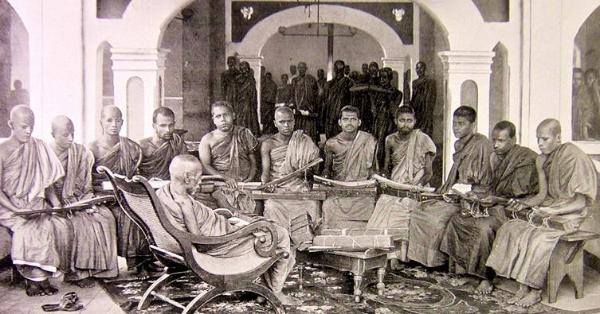
High priests reading from palm leaf books, circa 1900.
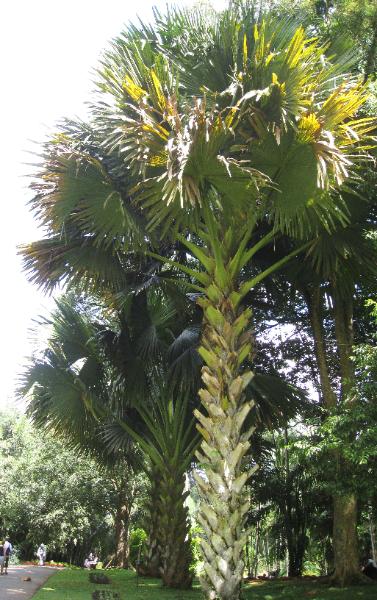
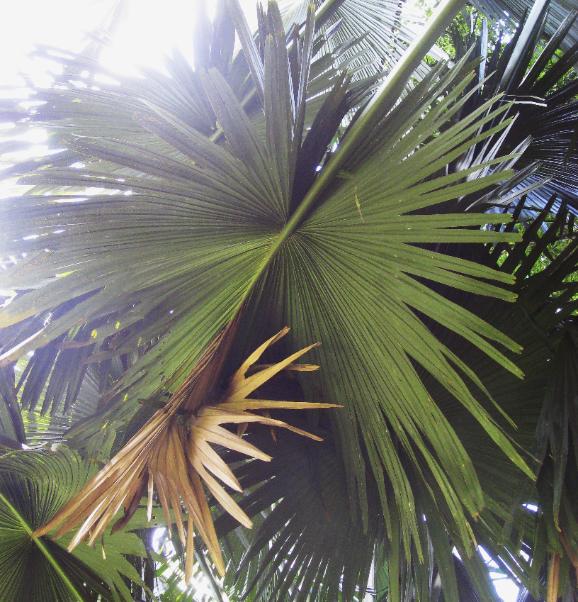
Talipot palms, Kandy, central Sri Lanka.
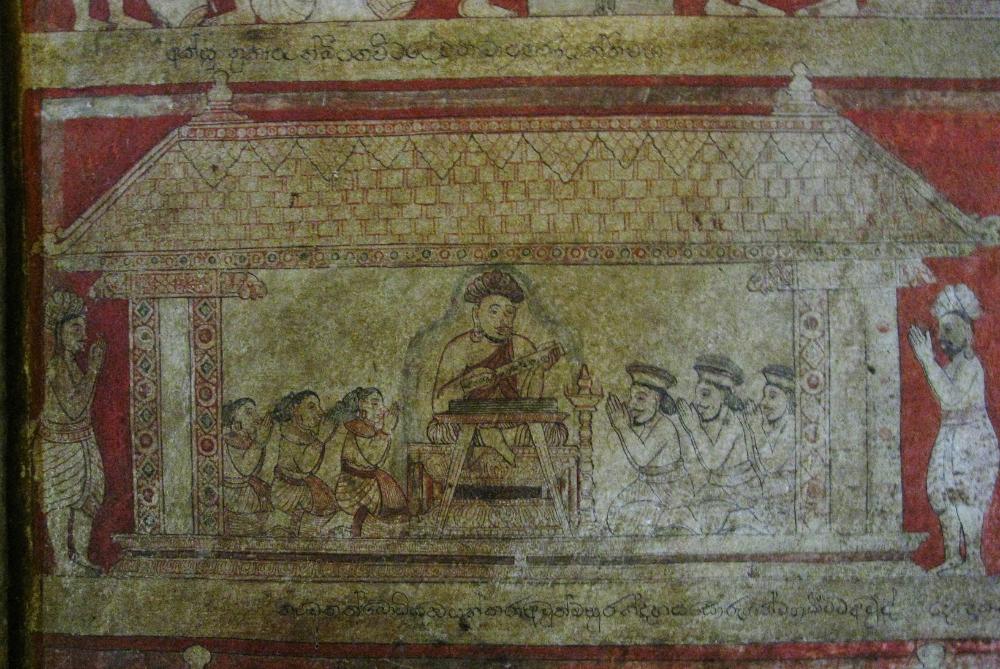
An eighteenth century cave wall painting at Degaldoruwa Temple, central Sri Lanka, which shows a Kandyan king reading from an ola manuscript.
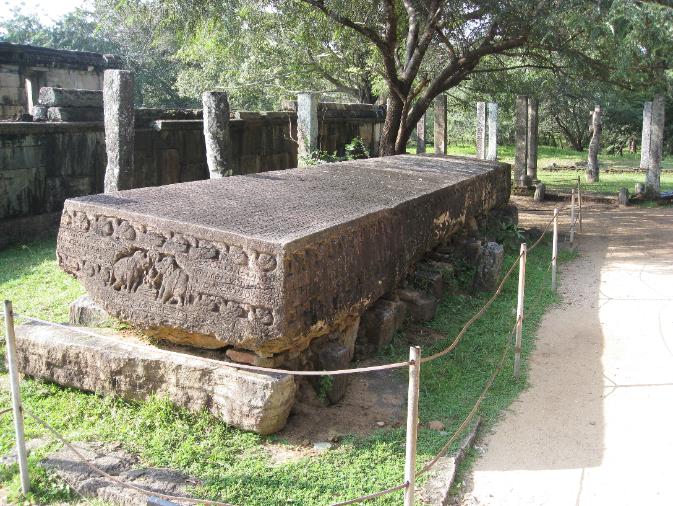
central Sri Lanka, assumes the shape of a large palm leaf manuscript. It was completed during the reign of King Nissankamalla (1187-1196AD),

